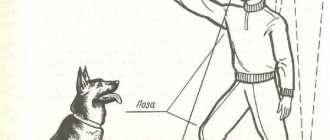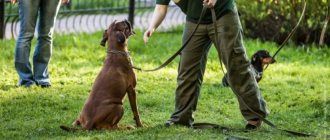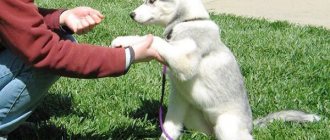If you get a dog, then you need to devote time to raising it, instilling discipline skills so that you are calm and those around you feel safe. The fastest way to resolve the situation is through training—teaching the dog commands. A disciplined dog will save you from:
- various problems while walking;
- destruction of a house or apartment;
- damage to clothes, shoes;
- dissatisfaction of passers-by;
- unexpected barking, squealing, and other things.
Raising a puppy and instilling discipline skills should be done starting from an early age - as experts recommend, from the moment the four-legged animal turns 3 months old.
Why do you need dog training?
Every owner wants to instill certain skills in their pet. For some, it is enough for a four-legged friend to bring slippers and calmly greet guests, others need reliable security, and others need an artist. All puppies are highly trainable, quickly acquiring specific skills with the right approach.
So, what is the purpose of learning commands?
- Educate.
The dog must understand the prohibitions and learn the simplest norms of behavior. This way all family members will feel comfortable around him.
- Discipline.
The four-legged friend, of course, is everyone’s favorite, but he must understand that the person is in charge. The animal gradually begins to respect and listen to the owner.
- Teach.
If a dog was purchased for certain activities (hunting, guarding, guiding), then it needs to be instilled with specific skills. This is usually done by experienced specialists.
The most pleasant bonus of training is the rapprochement between the owner and the animal. While playing happily, they respect and understand each other, which leads to a strong friendship.
Dog owner experience
Every dog owner makes mistakes when training them, but the main thing is to notice them in time and ask for help if necessary. Thus, experienced pet owners argue that the best way to teach a dog to follow commands is to earn his trust. With established mutual understanding, training will give the necessary results in a short time.
Important! Every mistake a dog makes is a mistake of its owner.
The dog should not be allowed to become overtired during tasks.
Self-study or coach training?
Many believe that proper dog training is only possible under the guidance of a specialist. In fact, you can teach your pet a lot on your own. Of course, this is a labor-intensive task. Puppies are very smart, capable, kind, but at the same time naughty. They strive to run away from the owner and mind their own business. Therefore, training in the simplest commands must begin at 2-3 months.
The owner needs to be as patient and restrained as possible. Not everyone can do this, so many turn to dog handlers. But, if you got a puppy just for fun, without planning to teach him specific skills, then you can safely do home training.
Commands for service dogs (“take”, “face”, “guard”, etc.)
There are situations when you need to train a service or guard dog. Here you will have to face a number of difficulties, since commands for them are considered the most difficult to master. It is better to train an animal under the guidance of an experienced instructor or even entrust the entire process to a dog handler. Improper training can result in negative consequences for the dog’s owner, those around him and other animals.
Trying to provoke aggression in a pet on your own is a huge mistake on the part of its owner. To train a dog with the commands “Take”, “Face” and “Guard”, 3 conditions are required: a closed area that excludes the presence of people in it, a protective suit and an experienced dog trainer.
Features of homeschooling
If you are concerned about how to train a dog at home, then remember that you need to be strict. If the student followed the order correctly, he should be praised, and if he disobeys, he should be reprimanded. Four-legged friends respond very well to intonation. It is enough to express dissatisfaction in a disappointed voice for the animal to understand its mistake.
Homeschooling has its advantages:
- classes in a familiar atmosphere eliminate stressful situations;
- the student listens only to his owner;
- no need to waste time on a trip to the dog handler;
- costs are reduced (travel, payment for specialist services).
At the same time, self-training has disadvantages:
- takes a lot of time and effort;
- limits training to a set of commands - not all skills can be taught at home;
- provides less training efficiency (especially if a particular breed is difficult to train);
- leaves the opportunity for the owner to commit incorrect actions, which often reinforces unwanted skills in the dog.
If you do not have the desire or experience necessary to train a breed that requires a special approach, consult a dog trainer. He will give recommendations on how to train a dog at home, taking into account its temperament and character. You may be interested in our article on dog handler prices.
It is also possible to train a mongrel, because it is not only purebred dogs that need training.
How to teach a dog commands: on your own or with a trainer?
Despite the fact that a dog is considered man's best friend, possessing extraordinary intelligence, initially any puppy is a cute, naughty creature. He has a habit of doing what he pleases, without regard to the wishes and requests of his master. Teaching your puppy commands at home should begin as early as possible. The ideal age for learning the first commands is 2-3 months. At this time, the puppy may well master the simplest skills.
Raising an obedient animal is a long, labor-intensive process that requires patience and endurance. Not every owner can do this, so inexperienced dog breeders often turn to an instructor. But, if you do not plan to take your four-legged friend to exhibitions or you have a decorative breed, you can do training at home.
Homeschooling has many advantages:
- the animal exercises in a familiar environment without experiencing stress;
- the dog learns to listen to its owner;
- saving travel time;
- financial savings.
- Disadvantages of self-training:
- takes longer;
- the effectiveness of training for inexperienced breeders is lower (especially if the breed is difficult to train);
- limited types of services and commands that can be taught to a dog;
- There remains the possibility of mistakes on the part of the owner, which can lead to the consolidation of unwanted skills in the dog.
If you decide to train your pet yourself, be prepared to be strict. For correct, successful execution of commands, you need to praise the dog, and for non-compliance, show your dissatisfaction. Animals pick up intonations very well, so it’s enough to express your disappointment with your voice.
If you have no experience in dog breeding or you have a breed that requires strict training, it is advisable to seek advice from an instructor. He will tell you how to teach your dog commands at home, taking into account its character, temperament and breed. It is not necessary for the dog to be purebred - mongrels also need good upbringing.
Pros of training an animal with a trainer:
- saving your time and effort;
- upon completion of the courses, a certificate is issued - it can be useful at exhibitions and competitions;
- regularity of classes;
- professional approach - the result will be achieved in any case.
Of the minuses:
- the dog gets used to the conditions of the school and to the trainer - the owner will have to make efforts so that its skills are transferred to everyday life;
- stress for the dog, especially for the puppy;
- Instructor services are not that cheap.
Each owner decides for himself whether to turn to a trainer or train the dog on his own. In both cases, the dog breeder will have to take the issue seriously and take responsibility.
Another important point in training is the owner’s self-discipline. Without it, raising an obedient dog is almost impossible - the owner needs to work not only on raising the animal, but also on himself. If you feel a lack of rigor and consistency, it is better to contact a professional trainer.
Specifics of training with an instructor
The owner himself makes the decision whether to train his four-legged friend at home or attend special courses.
Classes with a dog handler:
- save the dog owner’s time and energy;
- involve the issuance of a certificate, which will be needed if the dog participates in competitions and exhibitions;
- have regularity;
- guarantee results thanks to a professional approach.
But specialized courses also have disadvantages:
- a four-legged dog can take a long time to get used to a stranger, the school atmosphere, and experience stress;
- the owner needs to take action to transfer the skills acquired by the ward into real life;
- School services are quite expensive.
If you are seriously thinking about how to raise a dog at home and teach it commands, then know that one of the main points without which training is impossible is the owner’s self-discipline.
The latter should constantly work on himself, ensure regular training and rigor when training the puppy. If self-discipline is weak, then training should be entrusted to professionals.
Advice from a specialist
Before training a dog, a novice owner would do well to listen to the opinions of professionals who will make the training effective:
- Before the lesson, you need to put your pet on a collar and leash; for convenience, you can lay out a blanket.
- One command can be repeated no more than 2 times.
- The sequence of commands must be in any form.
- The training time should be no more than 1.5 hours.
- It is necessary to maintain an interval between commands, because the dog must rest.
- For a correctly performed exercise, your pet should be rewarded with affection or a treat, for example, you can choose a truffle that has a pleasant smell.
- Many owners buy dogs to participate in events. An exhibition, for example, is a place where not only the exterior is assessed, but also command training.
A well-structured training process will bring pleasure to both the owner and the dog. You just need to be patient, study carefully the question of how to train a dog, and the result will not take long to arrive.
Teaching Methodology
Many people think that you can’t raise or train an adult dog. They are confident that they can be trained only from puppyhood. This is not true.
Yes, kids learn various commands faster, so it’s easier to conduct classes with them. But an adult four-legged friend can also be trained. The main approach is regular training, proper handling, and great patience. You should not feel nervous if the dog does not immediately understand what the owner requires of him.
Where to train
The most favorable place for studying is an area that is well known to the student. It is advisable to exclude distracting circumstances: moving vehicles, active passers-by, other animals. If you happen to conduct training in an unfamiliar area, then you need to let your pet go for a walk and explore the territory. This will calm him down, and he will calmly return to his studies. When the dog gets used to one place, you can move to another area.
When to train
You can train at any time, subject to certain restrictions. You should not train a four-legged animal:
- immediately after he wakes up;
- in the heat - this can cause overheating, dehydration, and other unpleasant events;
- immediately after eating.
If you cannot avoid exercising during the hottest part of the day, take an adequate supply of drinking water.
What to take to training for encouragement
Reward your student with treats that he likes. This could be dry cookies or special food, cheese, meat, or other products.
In addition to treats, you can give your dog the right kind of praise. What does this mean? You need to encourage it right away. If the puppy has already completed the task a long time ago, and you just decided to praise him, then he will not understand it as it should.
Auxiliary items
For each training session it is necessary to take special items to facilitate the learning process.
- Trainer's bag for treats.
- Leashes - short (1 to 1.5 m long) and long (10 to 12 m long).
- Muzzle.
- Collars - regular and strict (made of metal). The latter is needed when the dog does not react to standard painful stimuli.
- Grip, or “rope”. This is a conditional opponent whom the student bites.
- Ringovka, aka noose. Used by applying physical force to adult quadrupeds. Models with a lock are attached to the desired location of the neck.
- Dumbbell - plays the role of prey. The student brings it with the order “Fetch!”, gives it to the owner with the command “Give!” You can't just play with her like that.
Take toys - a puller, an Arabian ball, a rope. They will help diversify the training process and facilitate learning.
Recommendations for self-study
Training dogs on your own requires compliance with the following recommendations.
- Regularity of classes. Or better yet, daily.
- Gradually increase the duration of classes. You can start with 15 minutes.
- Clear orders. Commands and rewards should be given different intonations so that the dog can distinguish them.
- Repeat the requirement no more than 2 times. Otherwise, the dog begins to understand that he doesn’t have to carry out the order the first time, but drags out time as long as he likes.
- Attracting the attention of your four-legged friend. To do this, use the animal's name, pronounced loudly and clearly.
- Constantly rewarding your pet for success. Use treats or praise, you can alternate.
Always maintain your composure if a student fails to complete assignments. If you raise your voice, your four-legged friend will also become nervous and quickly stop trusting you.
It is strictly forbidden to hit a dog.
How to feed small breed puppies
The first year of life is very important for small breed puppies, as all physical growth occurs during the first 12 months of life (8-9 for toy breeds weighing less than 5 kg).
This is the time when the body is laying the foundation for a long and healthy adult life, so the puppy requires special nutrition - food that has everything it needs to support healthy growth and immunity.
Small breed puppies have an increased need for energy: they are very active and burn calories quickly, and they also grow very quickly. As a general rule, the smaller the breed, the faster the puppies grow and reach adult size sooner. Rapid growth and important changes in the puppy's body require optimal levels of the right nutrients to ensure proper development of muscles, bones and internal organs.
Small breed dogs oral disease at an early age and the disease progresses more quickly than in larger breeds. This is why it is so important from the very beginning to give small breed dogs food that helps maintain clean, strong teeth and healthy gums.
In the first days of life, the puppy receives antibodies that protect its body from infections from its mother's milk. When a puppy is weaned from its mother, the level of antibodies drops sharply and the formation of its own immune system begins. She also begins to produce antibodies, but in small quantities. Over time, their number increases, but since the puppy’s immunity is just developing, this protection is not effective enough.
During this period, called the immune gap, the puppy is vulnerable to infections and digestive disorders. In addition, as in babies, stressful situations in a puppy's life can cause digestive disorders due to an imbalance in the microflora (bacteria) in the intestines. Separating from his mother and siblings and moving to a new home can be stressful events and upset his sensitive digestive system.
"Serious" games with puppies
The way we teach a puppy commands determines his future behavior. By the age of 3 months, the baby should clearly know his place in the house and not litter the room.
The main commands for entry-level training are: “Fu”, “Come to me”, “Place”.
The duration of the first workouts should be 15-20 minutes. Gradually, the time can be increased to 40 minutes a day. Long exercises will lead to fatigue and disobedience. To avoid this, you need to take short breaks (5-10 minutes), ending your workouts on time. This applies to students of all ages (especially if adult dogs have not been trained before).
To punish a four-legged friend, a severe reprimand in a dissatisfied voice is enough.
Training methods and nuances
Even before training begins, you need to carefully study your pet's behavior. Particular attention should be paid to the circumstances under which the dog begins to bark. The easiest way to find out is while walking while playing a game. It is necessary to note the dog’s reaction to any external factors. A dog can vocalize for many reasons: he sees his favorite toy, wants to eat, or simply barks because of the excitement that was caused by the game process.
To stimulate the dog to vocalize, you need to choose a suitable stimulus and make sure that he hears the word “Voice” during his barking. Gradually, the pet will develop a certain reflex - it will bark only when the owner gives the appropriate command.
Casting a vote on the ball
In order for a dog to bark on command, it must be accustomed to the fact that the owner giving the order behaves in a special way. If the puppy barks at the sight of a toy (for example, a ball), you can show him the ball and, when he starts barking, raise your palm and loudly and distinctly say “Voice!”
Encouragement is an important point in any training. Dogs can be stimulated in different ways: some will learn commands better if rewarded with affection, others need to be given some kind of treat. Training should be regular. You need to exercise your dog for at least 5 minutes a day. If the dog has performed the action required of him, he must be praised, stroked, or given a treat.
When the dog starts barking every time the ball appears, you need to move on to the next step - remove the ball and give the command by raising your hand. Soon the dog will begin to bark strictly on command.
Voicing for a treat
You can teach your dog this command using his favorite food. To do this, sit your pet nearby, holding the leash with your hand, let him sniff the treat, then immediately move your hand higher so that the dog cannot reach it (this is why a leash is required).
When the dog starts barking, you need to immediately say “Voice”, then give him a treat and pet him. Such exercises should only be done when the dog is hungry. After a week of training, the treat can be replaced with simple praise.
Voting for a company
Sometimes finding the right stimulus for learning can be extremely difficult. In this case, you can try to train the dog by showing it an example. To do this, you need to find a dog that already knows how to perform the “Voice” command, sit it next to yours and command both of them. A dog that barks on command should be rewarded immediately. The second dog will quickly understand what he needs to do.
It is important to train your pet not only to speak on command, but also to stop barking in a timely manner. The “Quiet” team will help you cope with this task. While the learning process is taking place, it is necessary to stop any attempts by the dog to bark for no particular reason.
Training with adults
It is more difficult to train an adult student. There are 3 reasons for this:
- Presence of established behavioral habits and character.
- Puberty - the work of hormones prevents the dog from responding promptly and correctly to the owner’s orders.
- It is difficult to “swing” an adult, to teach him to behave in a new way.
Despite various difficulties, the training is a success. But at the same time, it is necessary to conduct classes consistently, treat the student carefully and patiently.
Prepare to devote time from 3 months to a year to basic training. Think over your training methods, focusing on the character of your adult four-legged friend.
Avoid negativity when communicating with the student, as well as sudden movements (especially if the dog has attacks of aggression). Talk to him constantly.
Earn your pet's trust. This will help both of you complete the necessary training faster. Be sure to bring your favorite treats to every workout. Change the training area so that the dog is interested in learning something new.
There are special electric collars that ensure the student's obedience. But this is inhumane. This method can only be used by professionals when the animal poses a danger to others.
Answer
The puppy has the roots of a fighting breed, in the described case a Staff, which can be reflected in a mixture with Labrador genes in a not very pleasant way. As practice shows, the nature of the Labrador is friendly. The dog is characterized by the following manifestations:
- kindness;
- equilibrium;
- responsiveness;
- mind;
- obedience;
- tenderness;
- agility;
- weasel;
- affection for the owners.
A cross with another breed, not even a fighting one, causes serious changes in the puppy’s behavior. You should be vigilant; selected deviations from the classic Labrador character are unacceptable when communicating between a dog and children!
Main training commands
Basic orders correspond to instincts. By practicing regularly and patiently, the owner gradually understands how to train a pet so that it becomes attentive, obedient, and smart.
Before you begin training, it is necessary to develop the puppy’s skill of obedience and response to its name. Make sure that he immediately responds to your gestures, orders, and signs.
Below we have posted a list of basic commands, as well as brief instructions for practicing skills. Thanks to the information provided, self-training dogs will become an interesting activity for you.
"Sit!"
This is the first thing a puppy is taught. The order is used very often, since its main purpose is to calm the animal and force it to sit down at any time, regardless of the environment or the pet’s mood.
- When you start training, keep an eye on your puppy. As soon as he sits down, say “Sit!” Repeat over and over again so that your pet has a clear association between his actions and the words he hears. Gradually move on to fulfilling the person’s orders.
- To instill the skill, prepare treats and a short leash.
- Extend your hand with the treat upward (so that your pet can see it), clearly and calmly say “Sit!” Try to sit the puppy down. To do this, pull the leash up a little and lightly press on the pet's croup.
As soon as he follows the order, reward him (with a treat, praise).
"Lie!"
Owners do not use this command often, but it is necessary, for example, when visiting a veterinarian.
How to train a dog to follow orders.
- First, command “Sit!” After your pet sits, clearly say “Down!” and pull the leash down, slowly pressing on the withers.
- Act carefully and avoid sudden movements.
- The dog should lie flat, without leaning to one side.
Be sure to praise when the animal completes a task.
"Stand!"
Also a fairly common task. It helps a lot when the puppy needs to be dressed or brushed. The order is not complicated, but it is best to practice the skill when the pet reaches 6 months of age.
How to train a dog.
- First, give the command “Sit!”
- As soon as your four-legged friend sits down, clearly say “Stop!” and pick up the dog. The easiest way to do this is when the owner stands to the right of the pet. Grab it under your belly and lift it up.
- Hold this for 4-5 seconds, after which be sure to praise the student.
Be calm and patient. Otherwise there will be no benefit from the classes.
"Place!"
Usually your pet walks, rests, and plays where he wants. But there must be a special place in the apartment where the dog goes at the owner’s command. To practice this skill, use the corresponding “Place!” order.
How to properly train an animal to complete a task.
- Take the treat in your hand. Go to the mat with your puppy. Use your free hand to hold your pet's collar. Show him the reward in your other hand. Place it on the mat.
- Take the student to a distance, clearly command “Place!”, and release him.
- Increase the length of the distance each time. At the end of the training, your pet should return to his place, being in another room.
The key point of the training is that the animal should eat the treat from the mat, and not from the owner’s hand. This way training will give faster results.
How to teach a dog the commands “Come to me!”, “Near!”
Owners use these commands more often than others. The skill must be worked out perfectly, otherwise the pet will be impossible to control. Until the animal can clearly and timely follow these orders, it should not be allowed to walk without a leash.
- When you see that your four-legged friend is coming towards you, calmly and clearly say “Come to me!”
- As soon as your pet comes closer, attract its attention with a toy or treat.
- Gradually increase the distance between you and the puppy. It is necessary that the animal follows commands without seeing you, but only hearing you.
There are restrictions on the use of this order. If you plan to trim your pet’s claws or comb it, or carry out other procedures that are unpleasant for it, then do not use “To me!” This approach can cause a strong association of the team with fear, pain, and anxiety.
To master the execution of the order “Near!”, the pet must first run and play. This will make him less active and more receptive to activities.
- Moving slowly, keep the shortened leash close to the collar. Say “Nearby!” clearly.
- If the animal moves to the side, use a leash to return it to its place. Repeat the order.
- Once your four-legged friend has mastered the skill, speed up the walking pace. First use a quick step, then run. At the end of the training, change the pace, alternating speed with leisure.
The animal should always move parallel to the owner, being at the left leg. At the final stage, trained dogs perform the tasks “Come to me!”, “Near!” without a leash.
"Go for a walk!"
Usually this team takes a break from classes. The trainer rewards the animal with a walk after it completes a task. The coach gives the order “Walk!”, pointing in the right direction with his hand. Pets learn this skill very quickly; additional reinforcement in the form of treats or praise is not required to consolidate it.
“Give me your paw!”
The implementation of this order must be practiced in order to subsequently trim the pet’s claws and wash the pet’s paws without any effort. Dogs are trained as follows:
- Hide a treat in your hand and show it to your sitting four-legged friend. Do not open your palm until the dog tries to get the tasty piece with his paw.
- At this moment, say “Give me your paw!”, shake it, holding it in your hand.
- Reward the student.
Reward the animal every time it successfully completes a task (with a treat, praise).
“Ugh!”, “No way!”
A basic order that prohibits the puppy from continuing any activity. We teach the dog the commands “Ugh!” and “No!” in order to wean him from picking up unnecessary objects, throwing himself at people, and doing other things that disturb the peace of passers-by.
- Practice the skill on a loose leash.
- When the animal plans to disrupt public order or make other unwanted movements, sharply yank the leash, clearly, sternly saying “Ugh!”
The order should cause the student to associate with an unpleasant situation.
“Silence!”, “Quiet!”
You can begin mastering this command when the puppy reaches 2 months of age.
- The moment your pet starts barking, say “Quiet!” or “Be quiet!”
- When your four-legged friend is silent, reward him with a tasty morsel or kind words.
- Pause after the barking stops. If the student continues to remain silent, give him additional encouragement.
The animal should have a clear association - stopping barking means a reward.
“Aport!”
This order is an indispensable assistant when walking an active, energetic animal. You can start training your four-legged friend after the dog follows the commands “Come to me!” and “Sit!”
- Clearly say “Sit!”, show the puppy an interesting thing (toy, stick).
- The animal will want to take the item. Throw the stick or toy aside and command “Fetch!”
- Show your pet the direction in which to move.
If the dog starts playing, give the order “Come to me!” It is difficult for adult animals to develop a reaction to “Fetch!”; it is much easier to teach this to a baby.
"Voice!"
This command is quite difficult for four-legged friends to master. There are 2 ways. You can use both.
- Step on the leash in such a way as to limit the pet's range of action.
- Raise your hand with the tasty morsel up, give the order “Voice!” several times.
- The animal barks because it cannot get food.
- When the puppy vocalizes, reward him.
Make sure that the dog starts barking as soon as he hears the order.
Another method is to reward your pet when he begins to bark on his own at other animals or people. In this case, the four-legged friend must be in a place that is safe for others. Repeat “Voice!”, constantly rewarding the student for successful completion.
Remember that not all breeds like to vocalize. And some are not naturally able to do this.
"Fas!"
Team "Fas!" They train only four-legged animals that, having mastered the basic training course, have reached the age of 6 months. When ordered, the pet attacks the object. If the puppy has an unbalanced character, then you cannot teach him the task. In addition, training dogs at home does not involve mastering the skill, since in inexperienced hands the animal can become a dangerous weapon. The training is conducted only by a professional instructor.
"Wait!"
Usually the order is used in conjunction with “Sit!” and “Lie down!” To instill a skill in a student, proceed as follows:
- Stop with your four-legged friend in a certain place, calmly say “Sit!”
- When the dog completes the task, say “Wait!”
- Slowly moving back, repeat “Sit! Wait!".
If your pet has completed the task, approach him again and praise him. First, step back for 10 seconds. With each session, gradually increase the exposure time.
Commands for hunting dogs (“atu”, “tubo!”, etc.)
The prohibitory command “Tubo” is initially practiced during feeding: after giving the pet a little food, you need to pull the bowl away and command “Tubo”, and then give the command “Take”, allowing him to continue eating. After the dog has mastered this command, it is recommended to transfer it to all unwanted actions. The “Ato” command, like the “Take” command, is recommended to be taught to the animal under the supervision of an experienced instructor. Initially, the work is carried out on a leash.
The hunting command “Down” is similar to the order “Down” and is practiced in the same way. However, when hunting, it is not always convenient to command with your voice, so the animal is taught to lie down on a raised hand. To do this, when commanding “Down” or “Lie down,” they simultaneously raise their hand. Gradually the command is given only by hand.
How to train a mongrel dog
Team place
After the dog learns its name and begins to respond to it, you need to train the dog to go to its designated place - be it an enclosure, a booth or a rug in an apartment. To do this, take the puppy in your arms and grab a treat in advance, carefully sit him in the place designated for him and, stroking and treating him, say “Place, good place.” We perform this procedure several times over 2-4 days. At the same time, we try to give the command “place” when the puppy is next to you, you can even walk with him in the direction of his home. The main thing is not to forget about treats and generous praise. Training this command will not take you much time. However, you will have to secure it for the first month. Then the dog will voluntarily go to the place at the first command.
Stage two: learning unusual commands
Every owner wants to see his dog special, wants to teach him some unusual tricks. The desire to stand out is completely normal, because a well-mannered dog is the pride of the owner and the envy of others.
"Kiss"
To teach this command, contact with the owner must be excellent. This simple trick is based solely on trust between the pet and the owner.
To practice the skill, you need to sit the dog in front of you, say the command “Kiss” and, with a treat clamped in your teeth, lean towards the dog. Correct execution of the order looks like this: the dog places its front paws on its chest and licks its lips. Reinforcing the skill in this case is by encouraging the owner and receiving a treat.
"Serve"
To train, you need to sit your pet in front of you . Hold the treat in your hand in front of your pet’s nose, up and slightly back. The dog will try to reach the food and as soon as it lifts its front paws off the surface, command “Serve” and give the reward.
Another training option could be mechanical stimulation. When the dog is sitting, you need to take it by the front legs with your hands and lift it to the level of the dog's chest, at the same time a command is given. In the correct position, a treat is given, then you can release the dog.
"Spin"
To teach your dog the funny “spin” trick, you need to take a treat in your right hand and, using pointing, force the pet to make a 360-degree turn around itself . Immediately after this, give the reward. Only after several repetitions can you link the dog’s actions to the command, when the animal begins to understand what they want from him.
"Bow"
Executing the command is similar to the order “Lie down” . The dog must stand calmly in front of the owner. After giving the command “Bow,” move the hand with the food down towards the front paws. When a dog stubbornly lowers its croup in an attempt to lie down, you need to support the lower part of the body with your hand.
"Snake"
First, the “Next” command is executed, the dog stands on the left side of the person. The “Snake” command is practiced like this: there should be food in your hand, slowly lead it in front of the dog’s nose, passing your hand between the legs. The movements should be slow so that the dog understands what is required of it.
"Back"
It is not easy to train a dog to carry out this order - in nature, a dog does not walk backwards, it turns its body around.
Starting position – the dog stands in front of the owner. The command “back” is given and the person begins to move towards the dog. Instinctively, the dog will begin to back away a little so that the owner does not step on his paws. Even if the dog took just one step, this is already worthy of praise. The number of steps must be added gradually during training.
"Ring Jump"
The ring must be large enough so that the dog can easily pass through it. First, you need to place the ring on the floor and use a treat to show the direction of movement through the ring. When the dog passes, praise and give a treat. As you practice the skill, gradually raise the ring higher.
Eliminating rebellious behavior
Well-known dog training methods work here, slightly different for Labrador and Staff.
It will be necessary to check whether the disobedience was a manifestation of the dog’s rebellion. If the statement is true, the pet begins to look at the owner with a challenge, as if saying “let's see what you can do.” In response to such manifestations, try to repeat the command that you have learned and reliably reinforced. During puberty, when the pet becomes overly self-confident and tries to prove its own dominance, the dog will carry out the command without much desire. Otherwise, it is useful to remind your pet of your dominance.
You can’t start talking to your dog in a raised voice, aggravating the situation. The main thing is to use character and perseverance, and not force and shouting, otherwise similar weapons will be used against the owner.
You need to look the dog firmly in the eyes to feel that they are not afraid of him. When the rebellious emotions on the face begin to subside, repeat the command again. If completed successfully, the task is considered completed.











